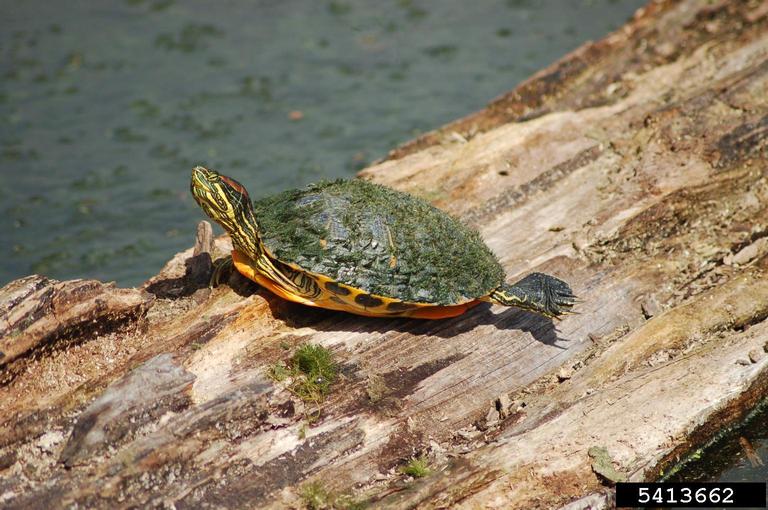Red-eared slider turtles have natural predators in the wild, which include raccoons, birds, and other turtles. In addition to these threats, they also face danger from habitat destruction and pollution.
They are often preyed upon as hatchlings, but as they grow older and larger, their size provides some protection. Despite these natural challenges, red-eared slider turtles have a widespread and adaptable nature that has allowed them to thrive in various environments.
Understanding the threats they face can help with conservation efforts and ensure their continued survival in the wild.

Credit: www.invasivespeciescentre.ca
Understanding The Habitat And Behavior Of Red-Eared Slider Turtles
Red-eared slider turtles have natural predators and threats in their wild habitat. Snapping turtles, raccoons, snakes, birds, and large fish are known to prey on them. They are primarily found in freshwater ecosystems like ponds, lakes, and slow-moving rivers. These turtles have distinct physical characteristics such as a red patch behind their eyes and a shell that can vary in color, often green or brown.
They are known for their ability to slide off rocks and logs into the water to escape from predators. Red-eared sliders are omnivorous, feeding on aquatic plants, insects, small fish, and crustaceans. They are active during the day and bask in the sun to regulate their body temperature.
Understanding their natural habitat and behavior is crucial for their conservation in the wild.
Predators Of Red-Eared Slider Turtles In The Wild
Red-eared slider turtles in the wild face a range of natural predators or threats. Coyotes, raccoons, and foxes are common predators that pose a risk to these turtles. Additionally, birds of prey like hawks and eagles often hunt and prey on them.
Snakes, such as water snakes and snapping turtles, also pose a threat to the red-eared sliders. These predators impact the turtle population by preying on eggs, hatchlings, and even adult turtles. As a result, the turtle population can be negatively affected, making it important to understand and address these threats.
Identifying these predators not only helps to protect the red-eared sliders but also allows for conservation efforts to be targeted towards reducing the impact on their population. By raising awareness about these threats, we can work towards ensuring the survival and well-being of these fascinating turtles in the wild.
Strategies For Defense And Protection Against Predators
Red-eared slider turtles possess various distinctive defense mechanisms that enable them to fend off predators effectively. They utilize their powerful jaws and sharp claws as weapons against potential threats. These turtles are also equipped with a hard, protective shell that shields them from attacks.
Furthermore, they have the ability to retract their head, limbs, and tail into their shell, making it difficult for predators to access their vulnerable body parts. Additionally, red-eared slider turtles have the impressive capacity to swim swiftly and dive deep underwater, allowing them to escape from danger quickly.
They are known to camouflage themselves in their surroundings, blending in with the environment to avoid detection. With these efficient defense strategies, these turtles have developed remarkable ways to survive in the face of natural predators and threats in the wild.
Environmental Threats To Red-Eared Slider Turtles
Red-eared slider turtles face natural threats in the wild, including predators like raccoons and birds. Human-induced threats, however, have a significant impact on their survival. Pollution, such as plastic waste and chemical runoff, damages their habitats. Habitat destruction due to urbanization and deforestation further disrupts their ecosystems.
Climate change also poses a threat as rising temperatures affect their ability to regulate body temperature and alter nesting conditions. These environmental pressures put red-eared slider turtles at risk and highlight the need for conservation efforts to protect their natural habitats and mitigate human-induced threats.
By addressing pollution, preserving habitats, and taking proactive measures against climate change, we can help safeguard the survival of these unique turtles in the wild.
Conclusion
Overall, it is clear that red-eared slider turtles face a number of natural predators and threats in the wild. From raccoons and birds to fish and alligators, these vulnerable turtles must constantly be on alert to survive. Their small size and slow movements make them easy targets, but they have evolved certain defense mechanisms like their ability to retreat into their shells for protection.
Despite these challenges, red-eared slider turtles have managed to adapt and thrive in various habitats around the world. However, human activities such as pollution, habitat destruction, and the illegal pet trade pose additional threats to their survival. Therefore, it is crucial that we take measures to conserve their natural habitats and protect them from harm.
By raising awareness and implementing conservation efforts, we can ensure that these beautiful creatures have a fighting chance to exist in the wild for future generations.





Leave a Reply